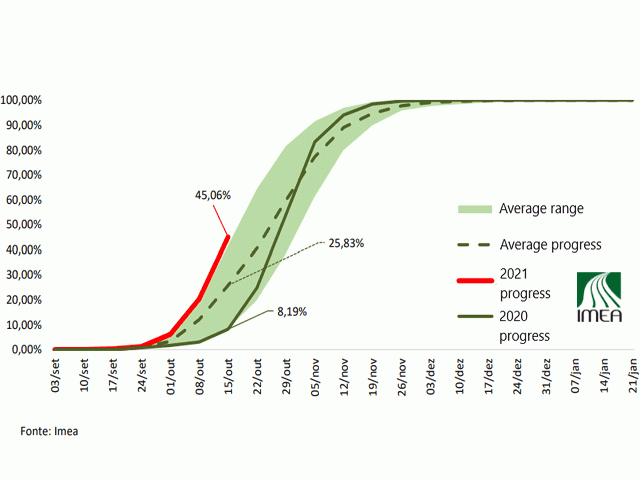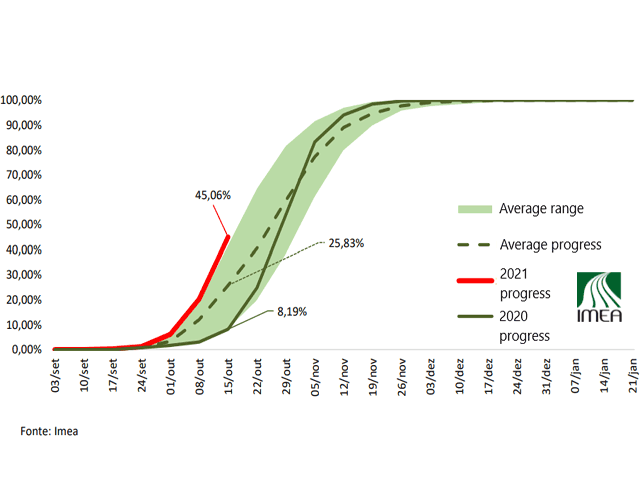South America Calling
Brazil Planting Progresses Very Quickly, Motivated by Double-Dip La Nina
Last year's grain marketing year, which encompasses the soybean growing season in 2020-21 and the double-cropped (safrinha) corn growing season in 2021, was characterized by the influence of a La Nina pattern. We at DTN have documented this almost continuously throughout the past year.
South American producers, of course, lived through the immense challenges and those are undoubtedly on their minds as the current season started, when La Nina was forecast to return. Starting their soybean planting early, especially with regards to last year, is a strong motivating factor in the face of this so-called double-dip La Nina -- a La Nina that follows another La Nina.
Soybean planting progress has already eclipsed 22% of expected acreage as of Oct. 14 according to AgRural in Brazil as a whole. That marks the second-fastest start to the season on record. Last year at this time, it was only at 8%. Mato Grosso, the county's largest production state for soybeans, has almost reached the half-way point at 45% complete according to the Mato Grosso Institute of Agricultural Economics (IMEA).
The graphic accompanying this blog shows the stark contrast from this year as opposed to last year, when planting progress in Mato Grosso was only at 8%, and the slowest over the last five years.
Producers this year are wasting no time and taking fewer chances. The rains have not followed a typical La Nina pattern, being much more beneficial to Brazil so far this spring.
P[L1] D[0x0] M[300x250] OOP[F] ADUNIT[] T[]
As mentioned in previous blogs on this site, La Nina generally has two major weather impacts for South American springs. First, it typically delays the start of the annual wet season in central Brazil. In 2020, the delay was around three to four weeks late and planting progress was much slower than normal. The second effect is to have drier conditions across Argentina and southern Brazil. That was a definite occurrence last spring as Argentina had dry conditions for planting at the start of the season.
This year has not really followed a La Nina pattern until recently. The wet season in central Brazil came almost exactly on time with scattered showers developing over Mato Grosso at the end of September and increasing early October across much of central Brazil's growing regions.
Southern Brazil, which typically is dry had plentiful rain from mid-September to mid-October. That was both uncharacteristic and welcome to area farmers dreading the impacts from La Nina.
Argentina was the only area that had been close to the expected La Nina pattern. Though scattered showers were moving through the country's growing regions in September and early October, amounts and coverage have been poor, and soil moisture conditions have degraded through much of the country's growing regions, particularly in the warmer central and northern zones -- large areas of corn and soybean production.
Water temperatures along the equatorial Pacific Ocean have just recently treaded into the La Nina classification. It has prompted the Climate Prediction Center in the U.S. to declare La Nina to be in effect. The Bureau of Meteorology in Australia, however, upgraded its position to a La Nina Alert, but have not made the jump to onset just yet.
This is in contrast to last year, when La Nina came earlier in the season, hitting criteria in August 2020 instead of October like this year. That earlier start is likely the reason why the 2020-21 season followed a typical La Nina pattern while the 2021-22 season really had not. And with temperatures finally getting into the La Nina range, it is likely why the pattern has finally shifted to one we would expect now. Brazil farmers appear to be in good shape for their soybeans, especially in the central growing regions.
We may see some adverse effects now that La Nina is taking hold of the pattern in southern Brazil. While soil moisture is good for now, drier conditions from the La Nina are likely to slowly decrease soil moisture over the next couple of months.
La Nina does not stop precipitation from occurring over Argentina and southern Brazil, but it does come less frequently and more scattered than widespread. This effect usually lasts into early summer. As La Nina typically wanes from December onward, the effects become less and less and the pattern typically gets wetter, increasing soil moisture for corn and soybeans and setting up the region for decent soil moisture for a double-crop of corn from late summer to early winter.
Rains across central Brazil should be very persistent over the next several months, giving good prospects to the soybean crop, which is forecast by the USDA and private entities to be a record crop this season.
With the crop being planted on time, safrinha corn should also be planted in the preferred planting window in January and February, keeping that crop on track to go through reproduction during the wet season before rains shut down in the fall.
John Baranick can be reached at john.baranick@dtn.com
(c) Copyright 2021 DTN, LLC. All rights reserved.






Comments
To comment, please Log In or Join our Community .